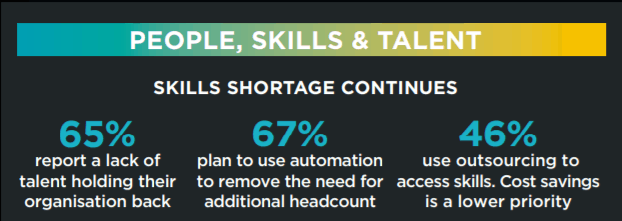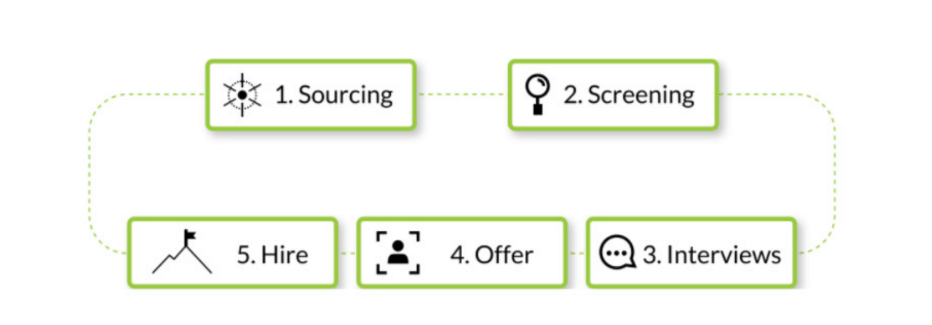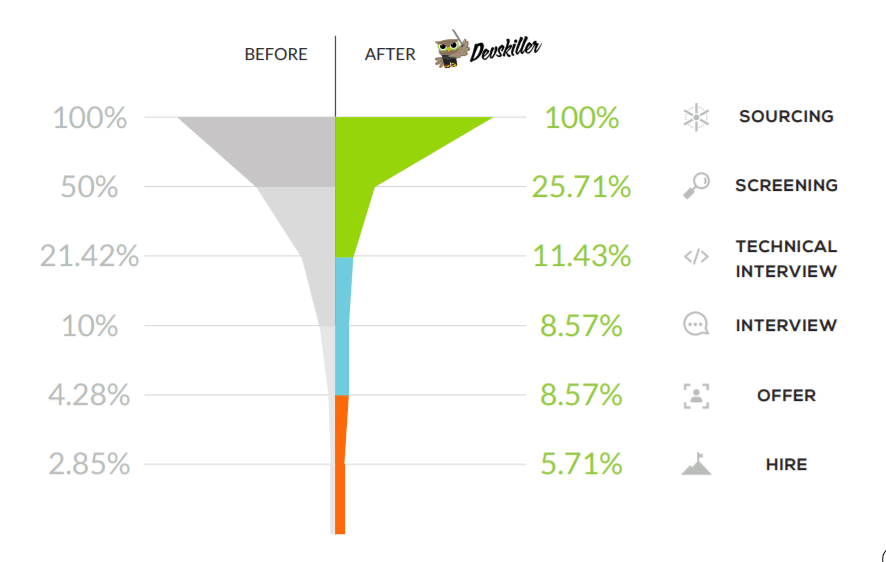
How to create and implement a recruitment plan

‘Those that fail to plan, plan to fail’, as the old adage goes. And this phrase rings true in the modern world of tech recruiting, too. A recruitment plan is an often overlooked element of recruiting developers of any level, despite the current tech talent scarcity. The annual Harvey Nash/KPMG 2018 CIO Survey focused on 3,900+ tech leaders who discovered that 65% of respondents believe that hiring challenges are hurting the industry (up from 59% last year).
 IT recruitment is without a doubt full of obstacles. A well-written recruitment plan can help you tap the existing talent pools and find the ideal candidates.
IT recruitment is without a doubt full of obstacles. A well-written recruitment plan can help you tap the existing talent pools and find the ideal candidates.
A recruitment plan is also a handy process to have nearby should you decide to target already employed talent.
In this article, you’ll learn:
- What is a recruitment plan?
- How to tailor-make a recruitment plan for your company.
- How to apply your recruitment plan to the hiring process.
Before you see the finer details of a recruitment plan, let’s make sure that we’re all on the same page about exactly what a recruitment plan is.
What is a recruitment plan
A recruitment plan is a strategy designed to streamline the hiring processes and act as a guideline for sourcing, qualifying, and interviewing job seekers. It acts as a timeline of events and actions to find qualified applicants while minimizing downtime for the company.

This helps employers ensure that they’re hiring individuals with the right qualifications, skills, and experience for the open position.
The role of a recruitment planning
A successful recruitment plan includes actionable steps and strategies that make the recruitment process efficient. It consists of a step-by-step process, as well as a list of resources that the hiring department relies on.
A recruitment plan details the steps and strategies used at every stage of the recruitment process:
- Sourcing.
- Screening.
- Interviewing.
- Offer.
- Hire.
We’ll go into more detail about these sections later, and exactly how they relate to a recruitment plan.
How to build an effective recruitment planning process in 8 easy steps
Now that you know exactly what a recruitment plan is, let’s take a closer look at what you’ll need on hand to build your recruitment plan.

If you’re new to technical recruitment, consider taking our Free Tech Recruitment Certification Course. It’ll ensure that you know the fundamentals before you sink your teeth into something bigger.
1. Look at the previous hiring processes
If you’ve hired many employees in the past, look at what worked and what didn’t work. Ask yourself questions like:
- Did the process reach the required goal?
- Was the position communicated well?
- Was there an acceptable number of applicants?
- How did the new employees perform during their probation period?
Creating a recruitment plan based on what has worked for you in the past will save you time. Consider consulting with managers and senior level employees to gauge their feeling on past hires, too.
2. Know your company & its needs
Once you’ve established what’s worked in the past and what hasn’t, take a step back and look at the bigger picture of the company.
Like everything in business, you should be working toward specific goals. When building a recruitment plan, it’s crucial that you know the goal of this position within the dev team, as well as the company.
Secondly, the company’s employer branding should also come into play. If your company does a lot of social integrations outside of work hours, you’ll want to hire someone that fits well with that.
 On the other hand, if your team works well together but rarely socializes together, you’ll want to make sure that the person you employ doesn’t have an excruciating need to know everyone about everyone they work with.
On the other hand, if your team works well together but rarely socializes together, you’ll want to make sure that the person you employ doesn’t have an excruciating need to know everyone about everyone they work with.
3. Skills gap analysis
A skills gap analysis is a methodical way of looking at the strengths and weaknesses of your current team(s) and identifying which skills you need to bring on board.
The best way to identify what you have and what you don’t have is to consult with senior developers and management. Ask them about the strengths and weaknesses of their team and then prioritize filling any skill gaps with the use of recruitment planning.
Note that hiring a full-time employee isn’t the only way to fill a skill gap. Consider a freelancer, part-time position, internship or other entry-level positions.
4. Revise job descriptions
To attract the right applicants, you need to present the position in the right light. What are the key responsibilities and skills that a successful applicant must have?
Certain roles can change over time. If you’re looking to hire, for example, a middle Java developer, talk to current middle Java developers. See how their roles have changed compared to the job that they applied for. It’ll be beneficial for you to list these ‘extra duties’ in order to create the most transparent and detailed job listing that you can.
If you’re not exactly sure what goes into the job description of a developer, look at existing job descriptions. Take a look at the open positions page of your competitors or other companies looking to recruit similarly skilled developers.
When you write a job description, remember to use a tone of voice that echoes your company branding. Statistics show that many developers who visit your open position listings are passive applicants – that is they’re not actively looking for a job. As a result, you’ll need to link to your careers page so that a potential applicant can easily learn more about your company and its roots.
5. Utilize technology
The recruitment process is by its nature a labor-intensive process. Some companies spend a lot of time manually screening and assessing each and every applicant to see how (if at all) they fit into an advertised position. Furthermore, manually screening each applicant can lead to cognitive bias. In a world where diversity in the tech industry is an inarguable benefit, you want to avoid bias at all costs.
By using technology to automate the screening process, you’ll limit the number of unnecessary interviews you’ll need to have. For example, using an on-site interview page, you’ll be able to uncover candidates that have coding skills way beyond their resume-creation skills.
Once you’ve found potential candidates, offer them an online coding interview. HR managers and senior developers spend (and waste) a lot of time creating coding projects to test applicants’ skills. By using an online test, you’re able to put the applicant’s skills to the test without exposing them to your code – or having to make the test yourself.
6. Set a budget for your recruitment plan
An often overlooked part of a recruitment plan is the budget. Most of the time, you in the HR department, are responsible for acquiring and maintaining the budget for hiring new staff. When it comes to recruitment planning, there are many traps you can fall into.
Your budget may or may not encompass the salary of the individual you’re required to hire. But you’re more than likely going to have limited funds when it comes to getting the open position out there. Unless you’re specifically targeting an individual, you may have to use PPC ads on Facebook or LinkedIn to get someone to apply. You may also have fees for an agency, or costs to perform some kind of background check.
To maintain an effective recruitment plan, you need to be sure that you keep your cost-per-hire rate as low as possible. Furthermore, average costs for recruiting someone via a specific channel (eg LinkedIn, word of mouth, or an agency) should be well documented to minimize the frequency of cost blowouts.
7. Optimizing your recruitment plan
Planning ahead and keeping track of your results allows you to continuously improve your recruitment efforts. There are many ways to optimize your recruitment process. One of them is to use recruitment software A well thought out plan can help you figure out where you have room for improvement. Another idea is to move things around in your process. A combination of many optimization efforts has the best effects. Example?
When Spartez changed from an in-house solution to DevSkiller and moved their technical interviews the process, they saw excellent results.
Source: DevSkiller case studies
The more efficient you are early on in the process, the better. That’s because you focus only on viable candidates. The good news this has a positive impact on your end result. Here’s what Lingonberry Talent Acquisition achieved with our technical screening and interview platform.
Source: DevSkiller case studies
8. Have a backup recruiting plan
You’ve spent a few weeks recruiting an ideal target, only for your developer to reject your offer at the last minute.
What do you do?
Well aside from getting frustrated, you resort to your contingency plan where you have a recruiting plan of action for such situations. The solution may be as easy as getting in contact with the next-best applicant. If you’ve been targeting a specific person for a while, then you may need to find the next best person and approach them.
Chances are that you’re hiring for a position because there’s a lot of work to do in that role. Sometimes an applicant comes close only to reject your offer at the last minute. Be sure to inform senior developers and/or managers so that they can manage the workload.
The fact of the matter is that a recruit that goes quiet or rejects you at the last minute is a real kick in the guts. It means that your work recruiting has amounted to nothing. But, the only thing you can do is go back to square one and start the process again.
Applying your recruitment plan through the hiring process
Once you’ve outlined what you’ll be using in your recruitment plan, it’s time to work through the recruitment process. As you do this, devise the role your recruitment plan will play in each step.
RECOMMENDED READING: Hack the process of recruiting programmers
Sourcing
Your recruitment plan should help you identify which skills you’re after and what roles people who have those skills hold.
This can take two approaches –
- You post your open position online and wait for applicants to come to you.
- You have a few candidates in mind and you reach out to them.
In a perfect world, you’d use both these techniques depending on the position advertised. The first one is more suited to a market flooded with talent, while the latter is ideal for when you know e.x.a.c.t.l.y who you want.
Whether you target a specific individual or a more general group of developers, personalization and relevancy are key. There’s no point in posting an open position for a Python developer in a Facebook group dedicated to iOS developers.
Why?
Because they’re not related.
If you’re targeting a specific person, personalize outreach messages as much as you can. A generic email that shows no prior knowledge to that individual is a surefire way of being ignored.
Summary: A recruitment plan shows the how and where you source candidates.
Screening
Once an applicant has applied for a job, it’s now the recruiter’s role to judge their eligibility. As mentioned earlier, a lot of time is spent on this process.
Using an online coding test or site-based application form early in the process means that you only interact with high-quality applicants.
For technical and highly-skilled jobs like that of a developer, it’s difficult for a recruiter to know exactly what skills are needed. Developing a recruitment plan that involved efficiently screening tech skills is a godsend for your hiring process.
Using an online test from DevSkiller’s library, you’re able to assess an applicant’s skills like it’s their first day on the job and not a job interview. DevSkiller users report a 60% shorter Time-to-Hire and a significantly higher quality-of-hire than manual methods.
Summary: Your recruitment plan showcases an efficient way of screening applicants and makes use of technology to do so.
Interviewing
Once an applicant has passed the screening phase, it’s on to the real-life interview.
If you’re hiring remote employees, the atmosphere and dynamic of an interview may be a little different to that of one done face-to-face. Be sure that you’re aware of illegal interview questions.
Throughout the interview, use a number of both behavioral and situational questions.
Behavioral questions are questions about an applicant’s past behavior. “What was a challenge that you had with your previous employer and how did you solve it?” for example. These questions help you build an overview of future behavior and gauge an individual’s confidence, problem-solving skills, and overall demeanor.
Situational questions involve hypothetical questions. ‘What would you do if…’ and ‘how would you…’ questions also help judge an applicant’s problem-solving skills and creativity. Furthermore, it makes them think quickly.
Also, consider asking an applicant to sit a test then and there in the interview. Perhaps finding and solving some kind of bug or erroneous code. This is a great way to truly challenge an individual and see how they perform under pressure. Be gentle, though – you want to test, not scare.
Remember that you don’t need to, and probably shouldn’t, get everything out of an applicant in a first interview. A second interview is great for verifying information delivered in the first interview and diving deeper into a developers skill set. Read more about what to ask in a second interview.
By the end of the final interview, you need to have enough information to offer the applicant a job. Therefore, you also need to know their expectations, requirements, and if they are actually interested in the position, now that they’ve met with you.
Summary: A recruitment plan outlines what types of questions are asked in the interview and what information is required to know by the end of each and every interview.
Offer
Once you’ve decided to offer a position to an applicant, create that offer and give it to the applicant immediately. The longer you wait, the less the applicant feels engaged with your position. Plus, a highly skilled and unemployed developer will usually have more than the one job offer in their line of sight.
A quick transition from interview to offer means that quality talent that leaves your interview wanting to work, is more likely to accept the offer.
 Many skilled applicants turn down offers because the remuneration isn’t to their liking. It’s best to come to a salary agreement during the interview process and be as accurate as possible when doing so.
Many skilled applicants turn down offers because the remuneration isn’t to their liking. It’s best to come to a salary agreement during the interview process and be as accurate as possible when doing so.
Create your offer and make it enticing – that’s not to say you need to add more to the agreed-upon salary, but a little surprise like a half-day Friday or remote work possibilities may make your applicant jump into a position a little more passionately. Plus, it shows good faith in you toward your new employee. Most importantly, be sure that salary standards and minimal work conditions are met.
Summary: A recruitment plan shows what needs to be included in a work offer, as well as a contingency plan should the applicant not accept the offer.
Hire
Once your application has accepted an offer, your job is done, right?
Not at all. The onboarding process is very much a part of a good recruitment plan.
Why?
Because one of the goals of a recruitment plan is to make each hire, regardless of position, done in the most uniform way possible.
On the day your new applicant starts, it’s up to you, the recruiter, to make them feel welcome and help them get their footing. This may be solely your responsibility, or you may hand the new employee over to their manager. A recruitment plan highlights the onboarding tasks and the responsibilities of the one doing the onboarding.
Want to take your recruitment plan to the next level and help out managers? Make your recruitment plan outline the targets and criteria for a new applicant to successfully pass their probation period.
Summary: A recruitment plan flows right up to the beginning of a new employee induction, and possibly even the end of their probation period.
Over to you to start recruiting
A recruitment plan can solve many of the problems that technical recruiters currently face. It is by no means a solution for every single recruitment problem. However, it plays a huge role in avoiding many common problems and streamlining the recruitment process.
A recruitment plan empowers recruiters to rethink the way that they hire and do so in a more efficient manner.
Your recruiting plan isn’t a cookie-cutter template for every hirer. That said, it does make the common facets of the hiring process more uniform. You need to tweak the process for each position at every stage.
How DevSkiller can improve your recruitment plan
If you’re a recruiter, remember to lean on the technology that’s readily available to you. DevSkiller can help you in both the screening and the interviewing process. Take a look at our range of ready-made skill tests and see you can use them in your current recruiting plan.






